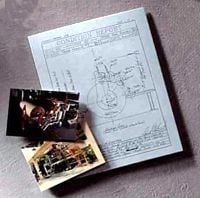Reel backlash due to worn parts causes sheet breaks, case study
Dec 1, 2020
Without warning, the loud and familiar sound of a sheet break shatters the relative calm of the night shift. The operator, shaking his head in frustration, quickly stuffs the discarded paper down the broke chute and once again, begins a new turn-up. Not only is this the third sheet break of the evening, but for the past week, the parent logs coming off No. 1 have been anything but acceptable. As a result, thousands of dollars in production have been lost.
The operator recognizes the sheet breaks to be more than coincidence. In reviewing his records, he determines that many of the sheet breaks have occurred at the reel, after sheet turn-up while a partial reel of paper on the spool has been in the primary arms. At approximately the 10 o'clock position, as the spool begins its downward arc around the drum, the sheet breaks occur.
Mill investigation
Mill maintenance inspects the reel for clues and discovers that the teeth of the pinion gear are worn concave and, in some cases, mushroomed. In addition, they find that the front pinion pillow block bushing has worked its way out of the pillow block, indicating misalignment of the cross-shaft. Further tests also reveal that the clutch between the drive motor and reducer is slipping more than normal. But how are these clues tied to the sheet breaks?
Valmet investigation - reel backlash

To confirm their backlash theory, the service crew measured the amount of backlash between the primary arm gear segments and pinion gears of both the front and back arms. They took measurements with the arms up and down, and with and without spools. The engineers searched for differences between the backlash measurements of the front and back arms, and measurements that exceeded the recommended tolerance of .005" to .015".
Further analysis
The findings revealed that with a spool in arms and lowered, there was a difference of .108" between the front and back arms, with a backlash measurement on the back arms as high as .255". The measurements were just as large with the arms in the other positions.
As further evidence, two more tests were conducted. The crew measured the clearances between the outside diameter of the reel drum bearing housing and the arm bore of the primary arms. The front gap measured .027" and the back measured .057" – well outside the recommended tolerance.
They then measured between the reel spool bearing housing and the reel rails with the primary arms down. The gap in the front measured .296" while the back was as large as .427" – a difference of .131". This confirmed that the backlash between the primary arm gear segment and pinion gear was causing the spools to come down to the rails out of unison, thus causing the sheet breaks after turn-up.
Adjusting the cross shaft?
The field service crew hoped that the backlash could be reduced by moving the position of the cross shaft. At first glance it appeared there was enough clearance in the holes to adjust the cross shaft up to reduce the backlash. But due to the severe wear of the teeth on the cross shaft pinion gears, adjusting the cross shaft could never produce enough gear mesh to eliminate the backlash.
Solutions - tighten loose fasteners, replace worn parts
To reduce near-term escalation of the backlash, the service crew tightened loose capscrews on the reel drum bearing housings, secondary arm cross shaft and reel secondary rails. However, to eliminate the problem, the service team recommended that the mill replace all worn parts at the next shutdown. The list of parts to be replaced included the primary arms with gear segments, cross shaft assembly, reel drum bearing housings, secondary arms, air cylinder seals and wear plates.
In this case, the mill chose not to accept the high number of sheet breaks and called in a field service team from the machine’s manufacturer. In doing so, they corrected a chronic and costly problem by replacing a number of worn parts at a planned shutdown instead of using minor adjustments that would only delay the inevitable.
For the most complete and accurate information on reel maintenance, contact your Valmet representative.